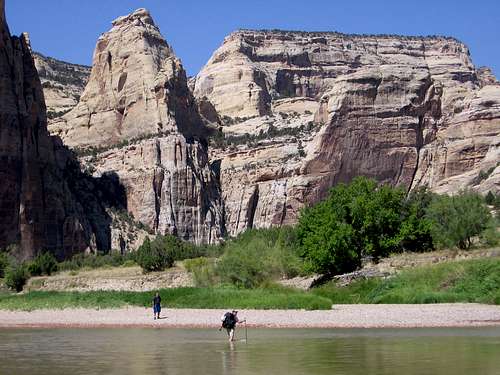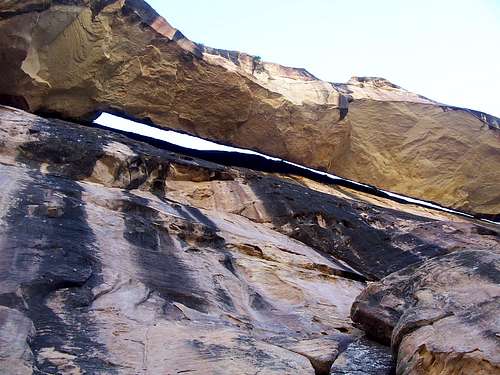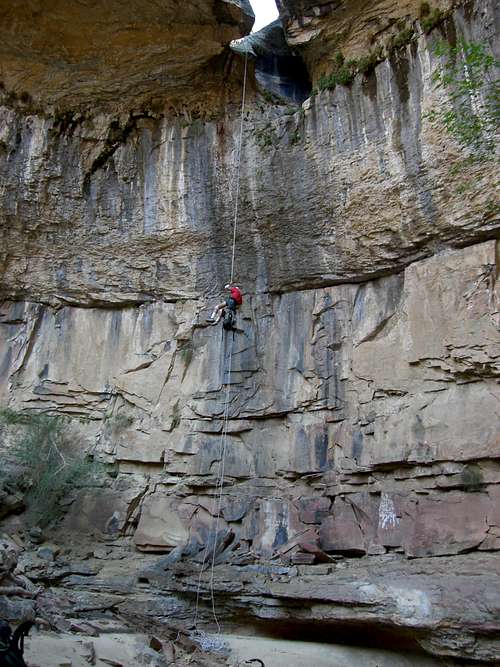|
|
Mountain/Rock |
|---|---|
|
|
40.50760°N / 108.9133°W |
|
|
Moffat |
|
|
Hiking, Mountaineering, Trad Climbing, Scrambling, Canyoneering |
|
|
Summer, Fall |
|
|
6489 ft / 1978 m |
|
|
Overview
So, do you like really remote peaks and territory? This is a really nice surprise. Pull open any guidebook to Colorado with the hikes and climbs marked, and notice the big blank spot in Northwestern Colorado. This area of Colorado, without question, has the most remote peaks in Colorado and almost certainly even has some un-climbed peaks. The peaks are incredibly spectacular and almost completely ignored, despite the fact that it offers some of the best scenery in the lower 48 states. Over a dozen very inaccessible peaks invite exploration. Only a few of the more accessible peaks are on Summitpost, but there is enough exploring here to keep one busy for years.There are all kinds of spectacular canyons here as well. From big and scenic to tight slot canyons, this area has enough exploring left for years. There are literally dozens of seemingly completely unexplored slot canyons in the area.
”Outlaw Peak” is the name we have given to Peak 6489 because Outlaw Park is the nearest named feature. The peak is very seldom climbed, and we thought that we were making the first ascent of the peak on September 3, 2006. We did however, find one cairn about half mile from the summit and 300-400 feet below it. No signs of previous ascent were on the summit, but the cairn was enough that we are not claiming it as a first. We left nothing ourselves except for some webbing and rings for rappel stations and some makeshift anchors in the canyons we used for the descent.
Putting this route up is one thing I have been working on and off for the last three years. A route from the north proved too rugged and impractical. A route from Mantle Park didn’t work out. There were a few more trips that ended without finding any viable routes to access the area. Finally in April 2006, we climbed the point on the south side of the river for a good close up view of Peak 6489. We got off track and just happened to spot the couloir that would be the key to the lower part of the route. The upper part of the route was discovered mostly by accident when looking for routes into the nearby canyon. The obscure route up to “Key Saddle” proved to be the key that unlocked the door to accessing Outlaw Peak and the nearby canyons.
In all my years of exploration in the area, I have only run into people in Jones Hole and Harpers Corner. The rest of the area is very little known. I’ve found one cairn, no hikers, and no footprints in all my years of traveling here, even on holiday weekends. Over Labor Day weekend, there was neither a soul nor footprint to be found for miles and miles around.
In the spring and early summer, many rive runners do run the Yampa River Canyon, and these are about the only people using the area. Climbers, hikers and canyoneers have always ignored the area.
Clean Climbing Ethics
Take care while visiting this area, because pockets of cryptobiotic soil exists in this region. Watch your step, especially in the flat areas frequented by bighorn sheep. Please use slickrock, rocks, riverbanks and sandy washes when visiting this area. Please leave as little impact as possible.The Discovery of Outlaw Arch
While climbing Outlaw Peak and descending Outlaw Arch Canyon, we discovered something special by surprise. What we discovered in the canyon and on a bench on the side of Outlaw Peak was a large natural arch. On September 30, I returned with Jeff Fox and got accurate measurements on the arch. At 206 feet, it turned out to be the 9th largest known arch in the world, and the largest "new discovery" reported in the United States since Wrather Arch (Paria River Canyon) was first reported in the 1950's. Only one arch since then has been reported to be over 200 feet and it is in Africa in 2004. One may wonder how an arch could be hidden for so long (until 2006!), but there are three main reasons.1. Since it stands against the cliff wall, it really isn’t visible from the air unless you know it is there. Now that we know it is there, it is visible on photos taken from the air.
2. The arch is not visible from below, and you can’t get to it from below.
3. The arch is well hidden in a remote canyon, and the route to get there is very obscure.
Before this one was discovered, the 10 largest known spans are below:
Largest Natural Arches and Bridges
Getting There
Note: Directions are going to be very brief and this is intentional. Pay attention to the landmarks when driving and make sure to use a good map. If you can’t find the trailhead on your own, then this is not the right place for you to go climbing. I would suggest doing something like Longs Peak instead.Briefly put: To get to the trailhead drive to the park headquarters of Dinosaur N.M., which is a few miles east of the town of Dinosaur, CO (Dinosaur is located on Highway 40 just east of the Utah border). Drive north on the Harpers Corner road for north until the Echo Park Road (gravel) takes off to the right (east). Drive the Echo Park Road to a junction. Turn right at the junction and head east along the Bench Road. Follow this road to the head of Red Rocks Canyon and Park. The road is sometimes too rough for passenger cars after leaving the pavement. Moderate clearance vehicles such as Subarus should do OK, but low slung cars can sometimes have problems.
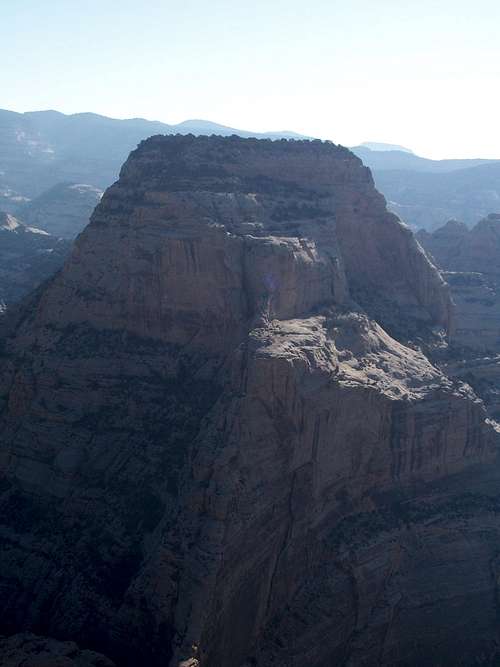 Sorry for the bad lighting, but this is the best photo I have showing Outlaw Peak from the west. The summit is well guarded by cliffs.
Sorry for the bad lighting, but this is the best photo I have showing Outlaw Peak from the west. The summit is well guarded by cliffs.Routes Overview
Approach Routes:There are three approaches to the base of the climb that will be discussed here. See the route page for more details.
Option #1
The easiest but the longest of the three approach routes is the one down Red Rock Canyon. Old cattle trails can be followed for much of the way down canyon to the Yampa River. Once the Yampa River is reached, you can follow more game paths down the river to Outlaw Park.
Option #2
Another route, slightly shorter than the one above is to hike cross country from the Bench Road to the big bend in the Yampa River north of the mouth of Red Rocks Canyon. You can scramble down to the river at the end of the point.
Option #3
The most direct way to the base of the climb is to head to and climb down the gully to the river. This is the most difficult route, and a very hot one when coming back out.
In my opinion, the best route is option #1. See the Approach Map for more details.
Summit Routes:
There seems to be at least two viable routes up Outlaw Peak, but I have only climbed one. The Key Saddle Route is quite easy once you know where it is. There is some exposure and much scrambling, but the crux pitch is only 5.4, making this one of the easiest and most accessible of the peaks in the area. See the ROUTE PAGE for more details.
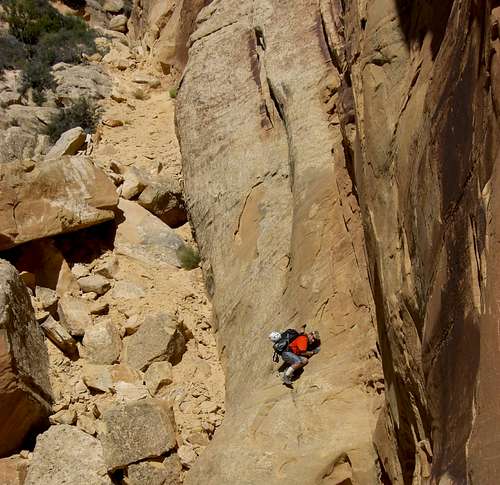 Part of the traverse on the Key Saddle Route up Outlaw Peak. Don't fall here as the drop below is a doozie and will kill you. The rock is also too soft to place protection, so it's better just to cross the traverses quickly, but carefully.
Part of the traverse on the Key Saddle Route up Outlaw Peak. Don't fall here as the drop below is a doozie and will kill you. The rock is also too soft to place protection, so it's better just to cross the traverses quickly, but carefully.The other route that appears practical is to climb the chute and chimney above and to the west of the Key Saddle. It is probably harder than the route described on the route page, but it looks like it should go.
Descent Routes:
From the summit of the peak, you could return the same way, but I would suggest descending either Outlaw Arch Canyon or Outlaw Canyon. Summitpost has separate pages for these two canyons, so see the links. Of the two, Outlaw Arch is the most spectacular route, but also the longer and more strenuous of the two.
Maps (click for larger image)
Red Tape
Camping permits are required for overnight use.The area is closed to climbing from March 1 through August 15.
Camping
After obtaining a camping permit, you can camp anywhere 1/4 mile or more from the road. There are some nice sandy beaches accross the river from Outlaw Park and another nice one on the far western end of Outlaw Park.Seasons
The best time of year to go is from mid-August to mid-October. To access the peak, you must wade the Yampa River, so the river must be low for this. Under 200 CFS would be ideal. Cooler weather will help on the ascent, but then the water gets cold. It was pretty hot for us in early September.The area is closed to climbing from March 1 through August 15 due to peregrine falcon nesting.
 Wading the Yampa near camp. You will want to do this trip before mid-October as the river will become very cold after that.
Wading the Yampa near camp. You will want to do this trip before mid-October as the river will become very cold after that.Mountain Conditions
WEATHER FORECAST FOR DINOSAUR NATIONAL MONUMENTSee the weather charts below for a general idea on the climate. These are just averages however, as in Spring or Fall you can either roast or freeze, often on the same day!
This is a land of extremes and it is not uncommon to have the afternoon be sixty degrees warmer than in the morning. At the quarry, an average night in January is 4 degrees, and an average day in July is 95 degrees, but temperatures have been as low as -40 or as high as 110.
Weather and climate data for the Dinosaur Quarry is below. *National Weather Service Data 1958-2004.
| MONTH | AVE HIGH | AVE LOW | REC HIGH | REC LOW | AVE PRECIP (in) |
| JAN | 30 | 4 | 60 | -39 | .51 |
| FEB | 39 | 11 | 66 | -40 | .62 |
| MAR | 54 | 24 | 85 | -13 | .65 |
| APR | 65 | 33 | 89 | 10 | .78 |
| MAY | 77 | 41 | 103 | 20 | .86 |
| JUN | 88 | 49 | 105 | 30 | .61 |
| JUL | 95 | 55 | 110 | 38 | .62 |
| AUG | 92 | 53 | 106 | 35 | .64 |
| SEP | 82 | 44 | 103 | 20 | .98 |
| OCT | 67 | 32 | 93 | 2 | 1.06 |
| NOV | 49 | 22 | 74 | -10 | .60 |
| DEC | 35 | 10 | 61 | -33 | .56 |


